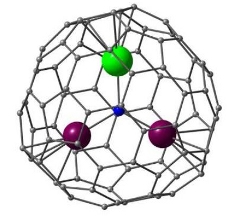While the role of asymmetric nitride clusters on the cage size and symmetry in fullerene-based structures is known, the role of the asymmetric arrangement of metals in nitride clusters on the nitrogen is not studied now. It is discovered that asymmetric mixed-metal nitride clusters give sufficiently narrow 14N NMR signals to make NMR the method of choice to characterize the endohedral cluster from the inside. In the series of mixed-metal nitride clusterfullerenes LuxSc3-xN@C80 and LuxY3-xN@C80 (x = 0-3) the δ(14N) values are found to be linear functions of x showing that 14N chemical shifts are additive values with specific increment for each kind of metal atoms. DFT calculations are performed to interpret the experimentally measured spectra. To reveal the main factors affecting 14N chemical shifts in nitride clusterfullerenes, shielding tensor components are analyzed in terms of Ramsey theory both in localized and canonical molecular orbitals. 14N chemical shifts in M3N@C80 and related systems are shown to be determined solely by nitrogen-localized orbitals, and in particular by the px,y,z atomic orbitals of nitrogen. As a result, the peculiarities of the nitrogen shielding in nitride clusterfullerenes can be interpreted by the simple analysis of the nitrogen-projected density of states and its variation in different chemical environments.

While the role of asymmetric nitride clusters on the cage size and symmetry in fullerene-based structures is known, the role of the asymmetric arrangement of metals in nitride clusters on the nitrogen is not studied now. It is discovered that asymmetric mixed-metal nitride clusters give sufficiently narrow 14N NMR signals to make NMR the method of choice to characterize the endohedral cluster from the inside. In the series of mixed-metal nitride clusterfullerenes LuxSc3-xN@C80 and LuxY3-xN@C80 (x = 0-3) the δ(14N) values are found to be linear functions of x showing that 14N chemical shifts are additive values with specific increment for each kind of metal atoms. DFT calculations are performed to interpret the experimentally measured spectra. To reveal the main factors affecting 14N chemical shifts in nitride clusterfullerenes, shielding tensor components are analyzed in terms of Ramsey theory both in localized and canonical molecular orbitals. 14N chemical shifts in M3N@C80 and related systems are shown to be determined solely by nitrogen-localized orbitals, and in particular by the px,y,z atomic orbitals of nitrogen. As a result, the peculiarities of the nitrogen shielding in nitride clusterfullerenes can be interpreted by the simple analysis of the nitrogen-projected density of states and its variation in different chemical environments.
